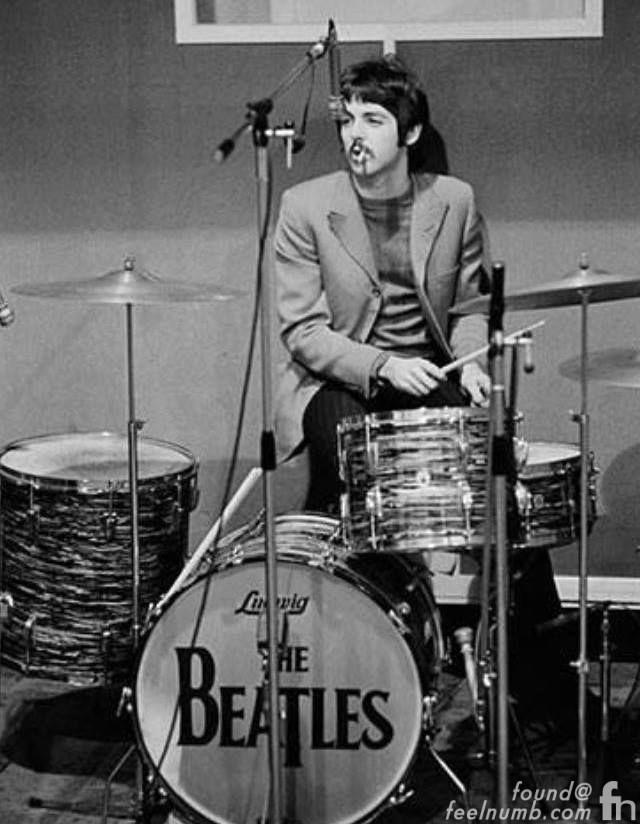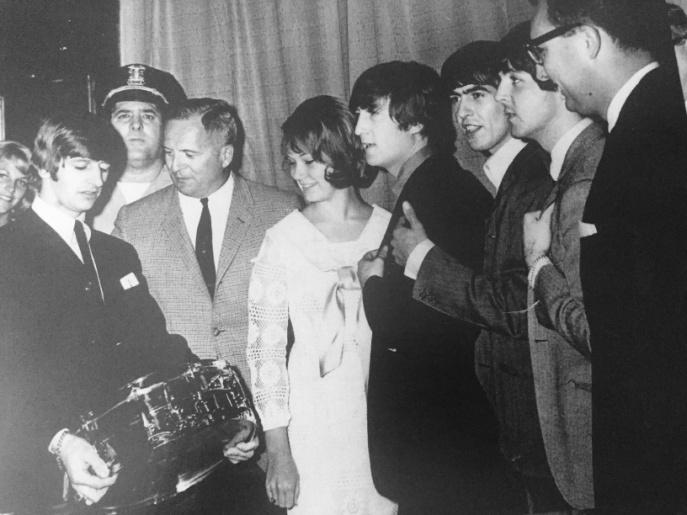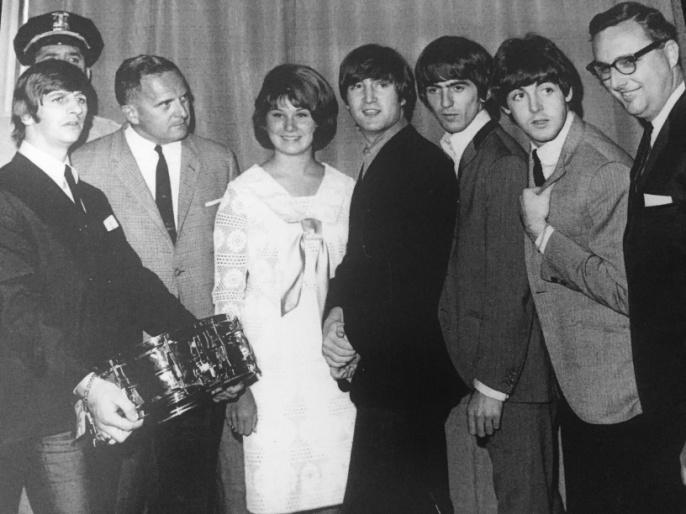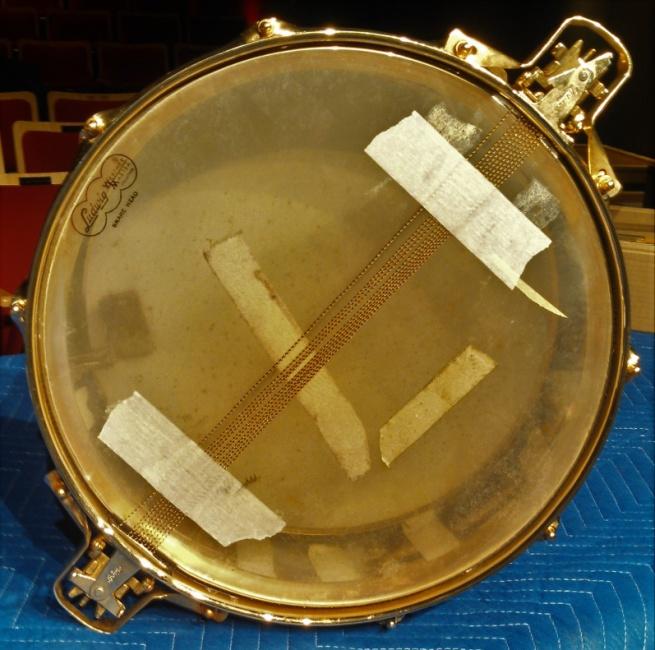On September 5, 1964, the Ludwig Drum Company presented Ringo Starr with a Super–Sensitive snare, plated in gold. Pictures were taken the moment he received it, and then the gilded drum disappeared. Or at least it seemed to.
Though The Beatles were among the most photographed humans on the planet at the time, this golden snare failed to reappear in a single photo, recording session notebook, or snippet of concert footage.
In the memoir The Making of a Drum Company: The Autobiography of William F. Ludwig II, the former president of the Ludwig Drum company confesses, “I was disconcerted by the image of the last time I saw the drum under the arm of a Chicago cop.”

From left to right: Dick Schory, Ringo Starr and William F. Ludwig Jr.
Photo courtesy of Ludwig Industries
If anyone was mystified by the disappearance of the golden snare, it was Gary Astridge. As you might recall from our article about Ringo’s other lost snare — Magical Mystery Drum: The Quest for Ringo’s Ed Sullivan Snare — Astridge is The Beatles’ drum archivist and gear curator.
He spent decades leafing through pages of magazines and books — even pausing on screen grabs — so he could astutely document every drum, cymbal, and piece of hardware that Ringo ever used.
While there’s no physical evidence of Ringo playing the golden drum, Astridge assures me that there’s a compelling backstory and plenty of entertaining theories regarding its fate.
The Glorious Gold–Plated Ludwig Snares
In The Making of a Drum Company, Ludwig Jr. recalls the inspiration for a run of gold–plated snares in the ‘60. “My mind went back to the glorious gold–plated drums of the glory days of Ludwig & Ludwig and the wonderful imitation gold plating on the black beauty models of the mid 1920s.”
The Ludwig Drum Company reportedly produced five gold–plated, Super–Sensitive snares made specifically for high–profile players.
That roster included Ringo Starr, Chicago–based percussionist Bobby Christian, Ludwig’s top endorser and Dave Brubeck’s drummer Joe Morello, Ludwig’s marketing director and Chicago Symphony Orchestra drummer Dick Schory, and Indiana University’s George Gaber who was the first–call percussionist of many famous conductors.
Each drum had the recipient’s name engraved on a small, gold–plated name tag that was fastened to the shell.
Unlike the drums from the ‘20s that Ludwig Jr. reminisced about, these five weren’t made with imitation gold. They were, in fact, brass shells covered in 24–karat gold. The drums were 5–by–14 inches and weighed about 12 pounds, with the exception of the George Gaber’s, which measured 6.5–by–14 inches.
A unique feature of Ludwig’s original Super–Sensitives were adjustable wires on the bottom of the drum. The number of wires would vary across the different Super–Sensitive models, but four of those golden snares had 10 adjustable wires and Gaber’s had 18.
A gold snare was certainly a generous, yet reasonable gift to an influential drummer like Ringo. It may have been offered to Ringo as a money–saving tactic.
Astridge shares, “One story I heard was that Ludwig [Jr.] caught wind that The Beatles’ manager Brian Epstein wanted an endorsement deal since Ringo’s decision to keep the Ludwig name on the bass drumhead — instead of peeling it off — made the company a fortune. But, instead of discussing endorsements, they decided to design the gold–plated snare as a thank you.”

(Photo from Feelnumb.com)
There is some truth to this rumor. In The Ludwig Book, Rob Cook explains how Buddy Rich had successfully negotiated an endorsement fee of $50,000. Ringo was never approached. Cook writes, “Mr. Ludwig was afraid to even think about what kind of fee Ringo might command.”
But according to Ludwig Jr.’s autobiographical accounts and Dick Schory, the golden snare was intended as a gift, not a means of avoiding an endorsement.
Sitting in his home office in Glenview, Illinois, 85–year–old Schory looks across the room and casually references, “I have one of them with my name engraved on it, sitting here in my office. I play it about every other day.”
Regarding his association with The Beatles, Schory recounts, “I was the one who had the relationship with [The Beatles’ manager] Brian Epstein. All of the servicing for the tours and the Ed Sullivan Show was my responsibility. And I met Ringo several times, too. He’s a very humble guy. He’s not hard to get along with at all. He was never demanding.
“He bought his first two Ludwig drum sets on his own. And after that, I figured, There’s something wrong here. So I called our UK distributor Ivor Arbiter and said, ‘Let me know when Ringo wants another set, and we’ll provide it to him free of charge.’ And we did.”
But the Ludwig company ended up wanting to do something more than just give Ringo some free kits. That brings us to the day of that fateful photograph.
Who Was Handed the Golden Snare?
Schory’s eye witness account of Ringo receiving his golden snare make it sound like the event happened a few months back, not an entire five decades ago.
He describes the upstairs ballroom at the International Amphitheater in Chicago that September day. About 150 photographers and people from the press were milling around the room. Ringo was handed that cumbersome golden snare for a photo op.
You’ll find all four Beatles in that photograph, alongside Dick Schory, William Ludwig Jr., and his daughter, Brooke. You’ll also see two unknowns: a young woman in the background and a man in uniform who has alternately been fingered as a security officer for the International Amphitheater or a Chicago Police Officer.
When I caught up with William Ludwig Jr.’s son, William (Bill) F. Ludwig III, at the Chicago Drum Show, he retrieved black and white 8–by–10 photos of the moment Ringo received the drum from Ludwig Jr. He placed two of the group shots side–by–side for comparison.
There’s a striking difference between the two photos that actually has nothing to do with Ringo or the drum but is humorous, nonetheless. Bill points out, “If you look at this photo on the left, my dad [Ludwig Jr.] looks happy. But over here, on the right, he’s not so happy. In between shots, McCartney leans over to my 16–year–old sister and says, ‘Hello, love. How about dinner after the show?’ And my dad heard that.”

Left to right: Unknown, Ringo, unknown Chicago Police officer or security guard, William Ludwig Jr., Brooke Ludwig, John Lennon, George Harrison, Paul McCartney, Dick Schory

Left to right: Ringo, unknown Chicago police officer or security guard, William Ludwig II, Brooke Ludwig, John Lennon, George Harrison, Paul McCartney, Dick Schory
Photos from the personal collection of William F Ludwig III.
As Schory tells the next part, “Then, we all had to get out of there. The Beatles had to go to their dressing rooms and get on stage.” Next, like a detective in a game of Clue, he postulates, “Ringo must’ve passed it off to Evans or the police officer, security guy.”
Astridge concurs with Schory’s assumptions by adding, “There’s a story that Ringo handed the snare off to Mal Evans [The Beatles’ assistant and road manager] and that Ringo never saw it again. There was another thought that the police officer had it and then the snare disappeared.
“I’m not here to confirm or deny these stories. If anything, I can say that I tried to verify the rumors, but I couldn’t track anything down to be true or false. All I know is that with The Beatles, there was so much going on back then and Ringo didn’t play it that night so he must’ve handed it off.”
Maybe the police officer took the gift and held it for ransom. Or maybe Evans dutifully placed the snare into its protective Ludwig case and stored it somewhere to maintain its pristine condition.
But who Ringo handed it off to that night may not be as important as the fact that it didn’t disappear forever.
An Aggressive Mystery Drummer
Ringo's golden snare resurfaced again almost 46 years later on his 70th birthday at the Metropolitan Museum of Art in New York. But when it showed up, it wasn’t in perfect condition.
A few years after the Met exhibit, Astridge was given exclusive access to the coveted golden snare.
“It was in its original black Ludwig case,” Astridge begins to describe the rare specimen. “As a collector, I was immediately drawn to that alone. [The case is] in remarkable condition. The crushed red velvet interior enhanced the majesty of the gold snare. Most Ludwig cases don’t hold up with time, and this one is a beauty.
“When I looked at the drum, I switched from collector to researcher. A few parts were missing and the original batter head was replaced by a worn calfskin head. There’s masking tape placed inside the drum shell. On the bottom, there was tape residue inside the shell and around the interior of the metal shell is a piece of ½–inch wide masking tape.
“So someone put it on there. And all I could think of was it’s a metal shell, and it was a little ringy, so someone tried to dampen the sound. There were also bits of tape on the resonant head and snare wires which made me wonder who played had this and when.”
“So, Ringo played it?” I ask, with a blend of assumption and modest curiosity.
“Well, that’s the million dollar question,” Astridge chuckles.
The obvious hypothesis is that Ringo played it. And, in fact, there’s evidence this might be true. According to Ludwig Jr., Ringo once told him that the golden snare “was safely stored in one of his homes in his native England and still played it occasionally.”
So that should be the end of story. Ringo handed it off to someone, then got it back after the engagement, and stored it somewhere safe until its display at the Met. Case closed, right?
The condition of the snare, however, suggests that it wasn’t just played occasionally and stored away. It was really played and, likely, modified.
Astridge has analyzed many of Ringo’s drums and has never seen one where the head was removed to put tape inside the shell.

The bottom of the Golden Snare. Photo credit: Gary Astridge
Astridge says that Ringo had other ways of dampening the sound. “A lot of times, he’d use a tea towel over the top of the drum. And, of course, you can see the tape on the outside of his shells. But I’d never seen him tape the inside shell on any of his drums.”
So, even if Ringo played it, there are clues that suggests someone else was tinkering with it, as well. However, the question of who might’ve played the golden snare really comes down to who would’ve had access to Ringo’s drums.
It’s been well–documented in books such as The Beatles Recording Sessions: The Official Abbey Road Studio Session Notes that during the making of The Beatles’ White Album, Paul McCartney would occasionally play on Ringo’s kit while recording songs like “Back In The USSR” and “Dear Prudence.”
Astridge adds, “As late as 1969 — could have been earlier — Paul borrowed one of Ringo’s Ludwig Downbeat kits, which was actually the 8–by–12 tom and 14–by–20 bass from Ringo’s very first Ludwig kit and the original 5–by–14–inch snare — not the 5.5–by–14 inches — and 14–by–14–inch floor tom from Ringo’s second Ludwig kit. It’s highly likely that the kit included some of Ringo’s cymbals, stands, and hardware.
“Paul used it on his first solo album entitled McCartney, and the kit is seen through the mid–’80s in photographs and music videos until it was finally returned to its rightful owner.”
While McCartney actually played Ringo’s kits, photos confirm precisely which pieces he used. And again, there’s no evidence that McCartney ever played the golden snare.
Moreover, the damage incurred by the snare suggests that someone was harsh with it — maybe a child, maybe an aggressive drummer.
Astridge reports, “A turning dial knob was missing, two wires were broken on the bottom, and there was another piece that was missing, as well.”
A second theory holds that the snare was disassembled and reassembled by a child, most likely Ringo’s first–born son, Zak Starkey. Now, Starkey would’ve only been a year old at the time his dad received the gift, but it’s possible that the golden snare might’ve found its way into Starkey’s hands just about any time during his childhood.
A final theory centers around Starkey’s godfather and late former drummer of The Who, Keith Moon. That would explain the wear and tear, since Moon was known for pulverizing — even combusting — his kits on stage. Moon was also a trusted friend of Ringo’s, who would’ve had access to at least some of his property.
And maybe it was Moon who let Zak play with it. After all, as Zak told Modern Drummer in November of 2006, “Keith was like an uncle, really. He was one of my dad’s best friends... Keith was the babysitter.”
An Exact Replica Is Born
It’s likely a definitive account of what happened to the golden snare in those intervening decades will never come. But perhaps Beatles obsessives like Astridge would never want it to.
A golden drum with a lost history — much less one built during one of Ludwig’s most storied periods — is the stuff of precious drum mythology. In knowing all the answers, we’re left with the end of a story. But in not knowing, the story of this drum can live on.
Instead, the drum lives through a curious story — and a precise replica. In the early 2000s, Astridge decided to officially complete his collection of Beatles drum replicas by acquiring his own golden snare.
He started by purchasing a 1964 Ludwig Super–Sensitive snare.
“I bought it. Took it all apart. Found the company in Brooklyn that did gold plating and sent it to them. A few months later, it came back and I had to wear sunglasses, it was so shiny. It was cool. I had to reassemble it using white gloves to avoid leaving fingerprints. I even had a nameplate engraved that said ‘Ringo Starr – The Beatles’ just like the original.”
Astridge once had the opportunity to show Ringo his replica. With his hands cloaked in white gloves as he held the bright instrument, Astridge walked up to Ringo who was quietly reading at his desk and said, “Hey Ringo, I made my own golden snare. What do ya think?”
Ringo turned to Astridge, tucked his chin into his chest and lifted his blue eyes above the top rim of his glasses to briefly examine the reproduction. Then, he nonchalantly turned back to his reading. Slightly surprised, Astridge asked bashfully, “Aren’t you even a little impressed or something?”
Ringo smiled a tinge and answered dryly, “Mine’s worth more.”
